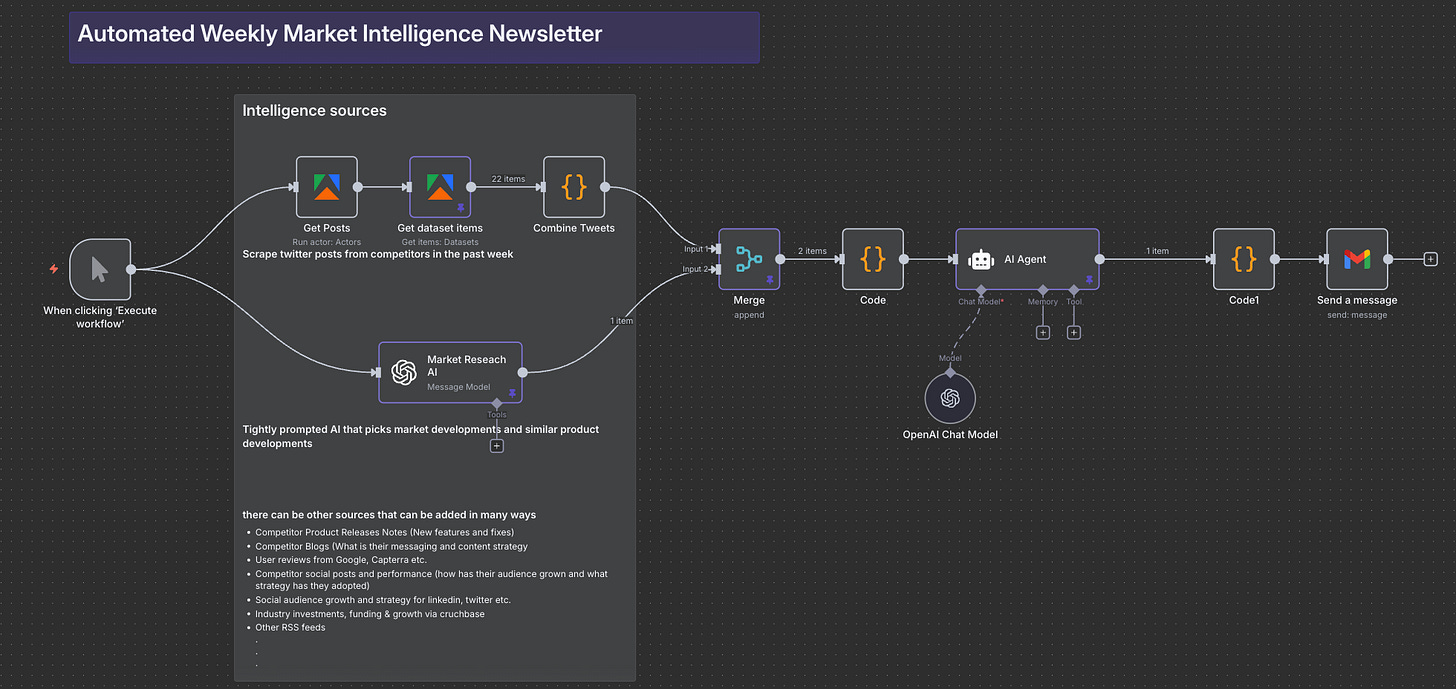Stop Obsessing Over Competition: A Market Intelligence Newsletter Built over a Weekend
A low-code workflow that turns endless updates into a calm, weekly briefing.
Every product team knows the drill. Staying up to date with the market is crucial, but it can also feel endless. New features, industry shifts, funding rounds, partnerships, even tweets. It is a firehose. Most of the time, someone ends up manually scrolling, Googling, and pasting links into Slack.
That cycle can quickly turn into an obsession with what others are doing. Instead, I wanted to bring some grace into the process. A calmer way to stay informed without burning mental energy on constant checking. So I built a simple prototype. An Automated Market Intelligence Digest that pulls updates from multiple sources and sends a clean AI summarized newsletter to the team every week.
The best part? It came together in just a few hours, without writing any code.
The Problem: Too Much Noise, Not Enough Clarity
Market intelligence often swings between extremes:
Too much information. Endless articles, release notes, and blog posts that no one has time to read.
Blind spots. Important moves get missed entirely if someone forgets to check the right site.
For a product team, this is a real risk. If an industry shift happens or a competitor changes direction, you do not want to find out months later. What the team needs is not more information. It is a calm, contextual brief that says: here is what happened, and here is why it matters to us.
The Build: Lean, Fast, and Automated
Instead of designing a giant dashboard, I focused on a weekly digest. Here is how it worked:
Monitor Sources
For the prototype, I only used two: competitor tweets and an AI powered research feed. But the workflow can easily expand to include:Product release notes from the industry
Blogs and thought leadership posts
User reviews from Google, Capterra, or G2
Social audience growth on LinkedIn, Twitter, or TikTok
Industry funding and M&A news via Crunchbase
Broader domain specific RSS feeds
Summarize with Context
Each update went through GPT with a tightly designed prompt template.
Instead of raw news, the output highlighted strategic angles. Opportunities, risks, or validation of our own roadmap.Compile and Distribute
The AI summaries were stitched into a short weekly digest. If a source had no major updates, it simply noted that.
Delivery was seamless. A Slack message every Thursday morning, ready to scan in few minute. It could just as easily live in Notion, Confluence, or email.
Tech stack used: n8n for workflow automation, OpenAI models for summarization, RSS feeds for structured updates, and social scrapers from Apify for capturing activity.
Why This Matters
The value is not in the complexity. It is in the consistency. With a simple no code automation, the team gets:
A reliable pulse on the market
Insights framed in our context, not generic industry speak
Freed up headspace to focus on strategy instead of scrolling
And because the workflow runs automatically, there is no risk of falling behind.
Lessons Learned
Start small. Even just two sources were enough to prove the value.
Context is everything. Raw summaries are nice, but framing them for your product makes them actionable.
Distribution matters more than dashboards. The digest works best when it is filtered thoroughly, kept light, and delivered where people already spend attention.
RSS feeds are the easiest sources to integrate, followed by research AI models, then direct APIs like Crunchbase, then social scraping, and finally HTML scraping.
This was not a massive engineering project. It was a lightweight and flexible workflow built in a weekend.
What Comes Next
I can imagine expanding this with richer sources, industry trend tracking, and simple dashboards for visualizing patterns. For example, which company ships the fastest or which topics gain momentum across the domain.
But the essence will stay the same. Calm, contextual updates that help product teams make better decisions.
Final Thought
Market intelligence does not have to mean obsessing over competitors. With a few no code tools and some prompt engineering, you can build your own automated digest and bring grace into the process. Free up your mind for strategy, creativity, and the work that really matters.
Tried something like this before? Or want to build your own version? I would love to hear what sources you would track. You can also find the project code in my GitHub repo here: Market-Intelligence-Newsletter


